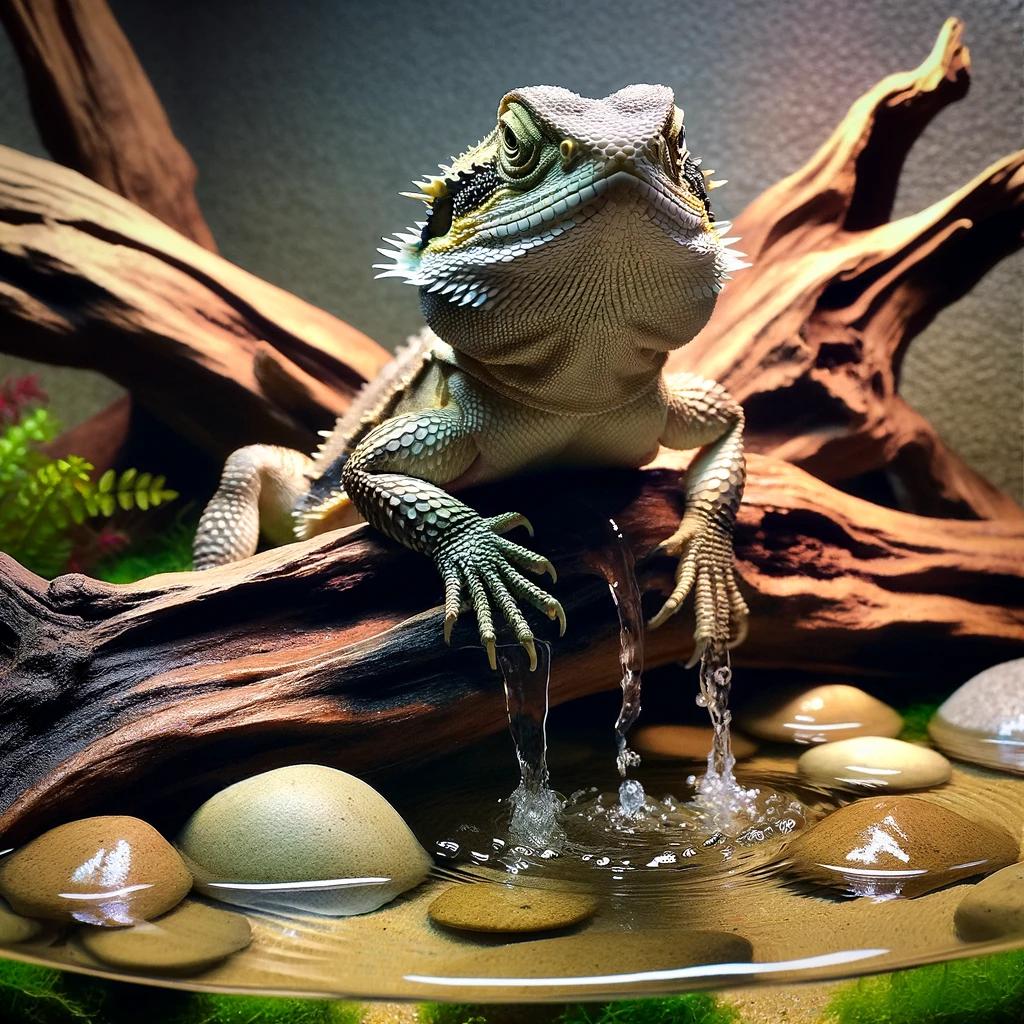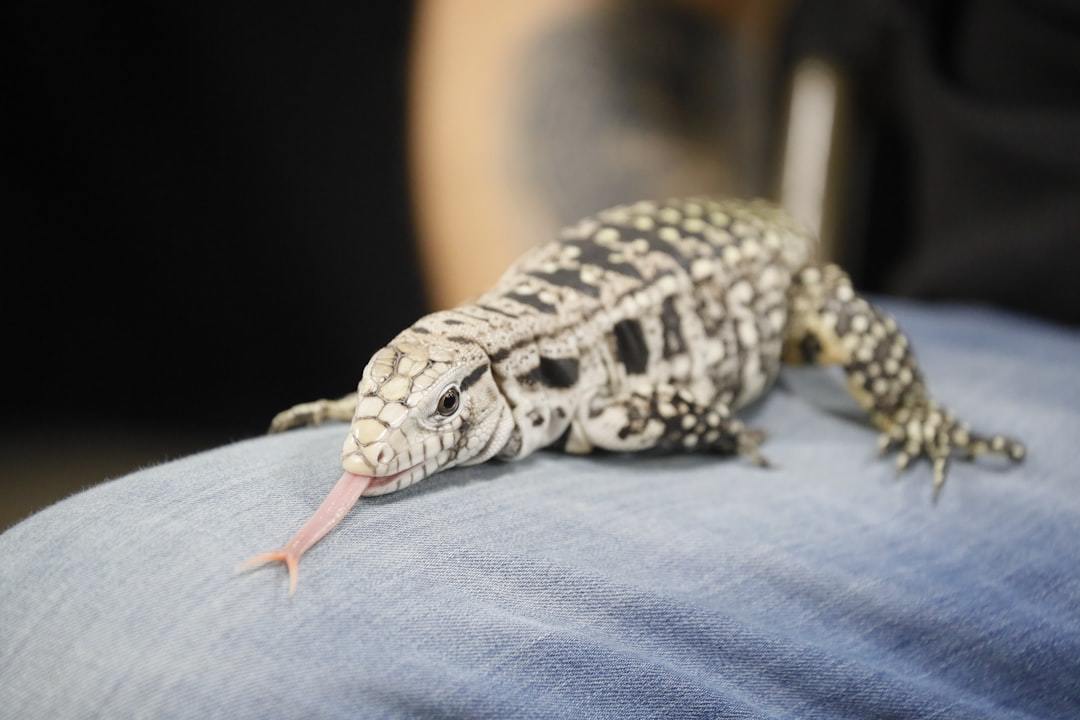Big Lizards as Pets
Big lizards as pets aren’t your everyday choice, but for those who dare, they offer an unmatched experience. Inviting these majestic beings into our lives transforms our living spaces and emotions, pushing us to grasp their distinct requirements and actions.
In this guide, you’ll learn how to pick the right lizard buddy that vibes with your lifestyle, create a cozy habitat they’ll love, nail their diet for optimum health, spot early signs of sickness to keep them thriving and weigh out the joys versus the jitters of having such an extraordinary companion.
Diving into the world of big lizard care is no small feat. But fear not; we’re here to make sure you start off on the right foot—or claw, taking good care of big lizards as pets!
Table Of Contents:
- Choosing the Right Big Lizard for Your Home
- Health Issues Common in Big Lizards As Pets
- Setting Up the Perfect Habitat
- Nutritional Needs and Feeding Tips
- The Pros and Cons of Keeping Big Lizards as Pets
- A Big Lizard, a Bigger Commitment
 AI illustration of a Water Dragon
AI illustration of a Water Dragon
Choosing the Right Big Lizard for Your Home
If you’re eyeing a big lizard as your next pet, think of it like choosing a new roommate. Not all will fit your lifestyle or home environment.
First off, consider size and space. Species like the Green Iguana can grow over 6 feet long. Make sure you have enough room for them to roam. Next up is climate control. These cold-blooded buddies need their surroundings just right—warm basking areas with cooler spots to chill out.
Diet’s another biggie. While some lizards are happy munching on greens and veggies, others might require live prey which isn’t everyone’s cup of tea. And don’t forget about personality; some species are more sociable than others.
Last but not least, ponder over the commitment. Some of these scaly friends can live upwards of 20 years—that’s a lot of time spent together.
Here’s a list of 10 big lizards that are popular as pets.
1. Leopard Gecko – Beginner: Known for their docile nature and simple care requirements, leopard geckos are nocturnal and don’t require large enclosures or UV lighting, making them ideal for beginners.
2. Bearded Dragon – Beginner to Intermediate: Bearded dragons are friendly and relatively easy to care for, though they require a larger tank, UVB lighting, and a varied diet, making them slightly more challenging than the most beginner-friendly options.
3. Crested Gecko – Beginner: These geckos are great for beginners due to their simple dietary needs (commercially available crested gecko diet) and minimal lighting requirements, though they do appreciate moderate humidity.
4. Blue Tongue Skink – Intermediate: With their distinctive blue tongues and docile nature, these skinks require a varied diet and a sizable enclosure, making their care requirements somewhat more demanding.
5. Uromastyx – Intermediate: These desert lizards need a hot, dry environment and a diet primarily of leafy greens, making their care unique but manageable for someone with a bit of experience.
6. Green Iguana – Expert: Despite their popularity, green iguanas require a very large enclosure, specific humidity and temperature gradients, and a complex diet, making them suitable only for expert keepers.
7. Water Dragon (Chinese or Australian) – Intermediate: Water dragons need a large enclosure with ample water for swimming, as well as specific humidity and temperature conditions, making them a challenge for intermediate-level reptile keepers.
8. Bearded Dragon – Beginner to Intermediate – Bearded dragons are personable and relatively easy to care for, making them a favored choice among new and seasoned reptile enthusiasts alike.
9. Monitor Lizards (e.g., Savannah Monitor) – Expert: Monitor lizards are large, active, and can be aggressive, requiring extensive space, specific diets, and careful handling. Their care demands extensive knowledge and experience.
10. New Caledonian Giant Gecko (Rhacodactylus leachianus) – Intermediate: Often referred to as “leachies,” these are the largest species of gecko, known for their impressive size and unique vocalizations.
This list showcases a range of big lizard species with varying care requirements, from those suitable for beginners to those best managed by expert keepers, considering factors like enclosure size, dietary needs, and environmental conditions.
Health Issues Common in Big Lizards As Pets
Big lizards can be fascinating pets, but they come with their own set of health challenges. Being aware of potential health issues is crucial in ensuring your large reptilian companion thrives.
If you have questions about the health of your big lizard, you can sign up for an online vet consultation with Ask A Veterinarian. They are available 24/7 to answer questions.
To avoid unexpected health costs, check out Pet Assure Mint.
Nutritional Disorders
Lack of a balanced diet often leads to nutritional disorders in big lizards. Metabolic bone disease is a common issue caused by insufficient calcium or vitamin D3. This condition weakens their bones, making them prone to fractures. Ensuring a diverse diet alongside adequate exposure to UV light stands as the cornerstone of prevention against metabolic bone issues.
Obesity is another concern due to overfeeding or feeding too many fatty foods like mice and certain insects without enough exercise. Keeping an eye on your lizard’s weight and tweaking its meals as needed is essential for its well-being.
Skin Conditions
Large reptiles often face threats to their skin’s well-being from mites and fungal diseases, which can severely impact their overall health. Mites appear as tiny moving dots on the skin, while fungal infections result in discolored patches or loss of scales. Frequent cleaning of their living space and vigilant inspection for any signs of creeping invaders can effectively prevent such health concerns.
Dysecdysis, difficulty shedding old skin, indicates poor humidity levels within their enclosure—a moist hide box usually fixes this problem quickly.
Setting Up the Perfect Habitat
Crafting a home for your sizable reptile that reflects its wild surroundings is essential. This means considering space, temperature, humidity, and lighting.
Space Requirements
Ensure your animal companion’s habitat offers ample space for exploration and movement. Think about it like designing a mini Jurassic Park without the chaos – spacious but secure. Checking resources like Reptiles Magazine can offer guidance for specific species size requirements.
Adequate space helps prevent stress and promote natural behavior patterns. Always opt for the largest enclosure possible within your means.
Temperature and Humidity Control
Lizards are cold-blooded; thus, regulating their body temperature through external sources is essential. This requires a setup with both warm basking areas and cooler zones to mimic day-night cycles accurately. A digital thermometer can help you keep an eye on these conditions effectively.
Maintaining proper humidity levels is equally important for your lizard’s health, especially for tropical species which may need higher humidity levels than others. To ensure the air isn’t too dry or moist for your lizard, a precise hygrometer becomes an indispensable tool.
Nutritional Needs and Feeding Tips
Our scaly friends flourish on a diverse feast, closely imitating their natural dietary habits in the wilderness.
For starters, variety is the spice of life for them. Imagine dining on crickets, mealworms, and even pinky mice – it’s all in a day’s eating for big lizards like monitors or tegus. But it doesn’t stop at live food; veggies play a crucial role, too. Leafy greens and squash should regularly appear in their bowl to keep things balanced.
Now, how often do you play Chef? Youngsters need meals daily due to their rapid growth spurt, while adults can do with less frequent feedings—think every other day or so. This keeps them healthy and mimics the feast-and-famine rhythm of their natural habitats.
The Pros and Cons of Keeping Big Lizards as Pets
So, you’re thinking about adding a big lizard to your family. Welcoming a giant reptile into your home can be immensely rewarding, yet it demands a hefty dose of dedication. Here’s the lowdown on what it’s really like having one.
Pros of Having Big Lizards as Pets
Lets start with the good stuff. Kicking things off, owning a large lizard is an immediate conversation starter due to their unparalleled distinctiveness. With their prehistoric looks, owning one is like having a piece of ancient history in your living room.
They also have surprisingly distinct personalities. Some might enjoy lounging around while others show curiosity and playfulness—much like cats or dogs.
Last but not least, these reptiles could be the perfect pet option for those allergic to fur since they don’t trigger allergies related to fur or dander.
Cons of Owning Big Lizards
Now for some challenges: Creating an ideal habitat can be both pricey and space-consuming. They need large enclosures with specific heat and humidity settings that mimic their natural environment.
Dietary needs are another consideration; feeding them isn’t as simple as scooping kibble into a bowl twice daily. Many species require live food or special diets that might not be easy to get hold of consistently.
Last up, health issues can arise if proper care isn’t given — from metabolic bone disease due to inadequate UV light exposure to stress-related problems stemming from small enclosures or improper handling. Reptiles Magazine provides more insight into common health concerns among large lizards.
A Big Lizard, a Bigger Commitment
Choosing big lizards as pets isn’t for the faint-hearted. Embarking on the adventure of caring for large reptiles demands a deep dive into their intricate necessities.
Picking the right lizard means matching it to your lifestyle, ensuring both of you thrive. Crafting an ideal environment is key—it involves replicating their natural surroundings to provide a sense of belonging.
Diet matters. Feeding them right keeps them healthy, highlighting the importance of knowing what they eat in the wild.
Spotting health issues early can save lives. Knowing when to seek help shows true care for these magnificent creatures.
Navigating through the trials offers hurdles and the gift of unparalleled fellowship. Embrace every step; let these extraordinary creatures enrich your life.

